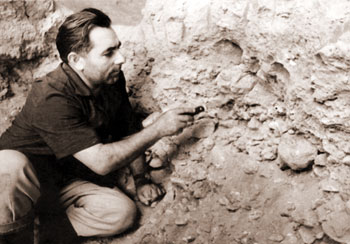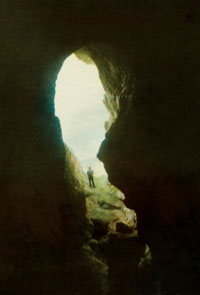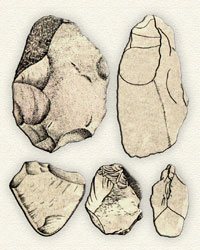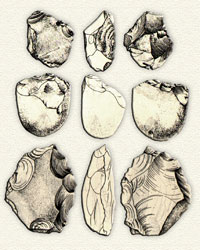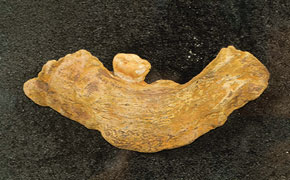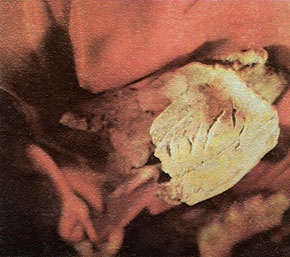Pages 52-57
Considering the great contribution this find made to world science, we present the article “Azykh Cave” by the late Professor Husseinov, which retains its historical significance.
Explorations of Azykh Cave – 50 years on
The archaeology of Azerbaijan is unique and has enriched the world’s heritage with a number of specific archaeological monuments and findings. The exploration of these discoveries has acquired a history of its own and the 50th anniversary of the exploration of the Azykh Cave (Karabakh, Azerba?an), which is an archaeological wonder not only for Azerbaijan but for the whole world, is certainly one such historic event. Archaeological excavation of the Azykh Cave began in 1960 and the jaw bone of an ancient man was discovered there in 1968. The finding was entered into the annals of history as Azykhantrope by the eminent Azerba?ani archaeologist and Doctor of Historical Sciences, Professor M. M. Husseinov.Considering the great contribution this find made to world science, we present the article “Azykh Cave” by the late Professor Husseinov, which retains its historical significance.
The Azykh Cave
A number of prehistoric caves have been explored and studied by archaeologists from the Institute of History of the Academy of Sciences of the Azerba? an SSR. Among them are the Dashsalakhly and Damjily caves, the Shushagala cave, the Kilit and Dashkala caves and the Azykh and Taglar caves, all in the Azerbaijan SSR. These caves date back to various periods of human history.The Azykh cave is of particular importance to world archaeology and can boast of unique discoveries.
The cave was found by Mamedali Guseinov in 1960 and systematic investigations have been carried out there ever since. Scientists of other disciplines, D.W. Hajiyev, A.V. Mamedov, N.S. Shirinov, V.V. Velichko, A.C. Gafarov, V.M. Hajiyev, S.D. Aliyev and others, have also been involved in detailed studies of the cave.
The cave is situated on the very edge of the south-eastern slope of the Karabakh upland, within the territory of the Azerbaijan SSR and on the border of South Azerbaijan, where the River Araz cuts through the slopes of the Lesser Caucasus and the Mil and Mugan Steppes. The cave is on the left bank of the River Kuruchai, some 900 m above sea level. The cave entrance faces the Kuruchai river valley, a picturesque environment with very rich soil. The south-western and north-western parts of the valley are both protected by high massifs covered by alpine meadows (2, 725 m above sea level).
To the North and South, the cave is surrounded by a forested area of the foothills. Stepped terraces of varying heights (from 3 to 220 m) run to the east. The terraces begin at the cave and descend gradually until they merge with the Mil Steppe.
Connected to the Mil Steppe on one side and highland and upland zones on the other, the Kuruchai valley has always had climatic conditions very favourable for life. In ancient times, as far back as the Late Pliocene and Early Pleistocene periods, fauna from various environments entered the cave area from the Kuruchai valley, followed by primeval people similar to Homo habilis, who lived in East Africa about two million years ago.
The area of the Kuruchai valley, where the Azykh cave is situated, is very rich in raw materials for producing work tools. Among them are quartz, quartzite, flint, basalt, chalcedony, felsite and jasper, to name a few. The Azykh cave is of karst origin and was formed mainly during the Late Aktchaghyl-Absheron era. The cave roof is under an Early Middle Aktchaghyl peneplanation, while its fl oor is level with the 11th terrace (180-200 m) of the River Kuruchai which was formed during the Absheron era.
Once this terrace had been formed and the Kuruchai river-bed was lower than the cave entrance, thus eliminating the danger of inundation, it was possible for man to inhabit the cave. The cave is the largest of its kind within a karst formation known so far in Transcaucasia. Along with other micro entrances, it is more than 600 m long and has a total area of at least 8,000 square metres. The cave includes 8 majestic grottoes with high (20-25 m) domes and multiple mazed and blocked passages. Characteristic of the cave are unique stalactite and stalagmite columns (about 2 m high and 0.5 to 1.5 m in diameter). In all the grottoes attention is drawn to sintered formations and large natural shelves, which give the impression of being fixed to the walls. These elements comprise one of the significant decorative features of the cave.
Over the last two decades ten layers, with a total thickness of 14 m, dating from different periods of the Early Paleolithic era, have been identifi ed in the southern entrance zone of the cave.
All layers of the Early Paleolithic era have been identified in the cave: the Chelleen (Oldowan) or pebble culture, Early Acheulian, The cave is situated on the very edge of the south-eastern slope of the Karabakh upland, within the territory of the Azerbaijan SSR and on the border of South Azerba? an, where the River Araz cuts through the slopes of the Lesser Caucasus and the Mil and Mugan Steppes.
The cave is on the left bank of the River Kuruchai, some 900 m above sea level. The cave entrance faces the Kuruchai river valley, a picturesque environment with very rich soil. The south-western and north-western parts of the valley are both protected by high massifs covered by alpine meadows (2, 725 m above sea level).
To the North and South, the cave is surrounded by a forested area of the foothills. Stepped terraces of varying heights (from 3 to 220 m) run to the east. The terraces begin at the cave and descend gradually until they merge with the Mil Steppe.
Connected to the Mil Steppe on one side and highland and upland zones on the other, the Kuruchai valley has always had climatic conditions very favourable for life. In ancient times, as far back as the Late Pliocene and Early Pleistocene periods, fauna from various environments entered the cave area from the Kuruchai valley, followed by primeval people similar to Homo habilis, who lived in East Africa about two million years ago.
The area of the Kuruchai valley, where the Azykh cave is situated, is very rich in raw materials for producing work tools.
Among them are quartz, quartzite, fl int, basalt, chalcedony, felsite and jasper, to name a few. The Azykh cave is of karst origin and was formed mainly during the Late Aktchaghyl-Absheron era. The cave roof is under an Early Middle Aktchaghyl peneplanation, while its floor is level with the 11th terrace (180-200 m) of the River Kuruchai which was formed during the Absheron era. Once this terrace had been formed and the Kuruchai river-bed was lower than the cave entrance, thus eliminating the danger of inundation, it was possible for man to inhabit the cave. The cave is the largest of its kind within a karst formation known so far in Transcaucasia. Along with other micro entrances, it is more than 600 m long and has a total area of at least 8,000 square metres. The cave includes 8 majestic grottoes with high (20-25 m) domes and multiple mazed and blocked passages.
Characteristic of the cave are unique stalactite and stalagmite columns (about 2 m high and 0.5 to 1.5 m in diameter). In all the grottoes attention is drawn to sintered formations and large natural shelves, which give the impression of being fixed to the walls. These elements comprise one of the significant decorative features of the cave.
Over the last two decades ten layers, with a total thickness of 14 m, dating from different periods of the Early Paleolithic era, have been identified in the southern entrance zone of the cave.
All layers of the Early Paleolithic era have been identified in the cave: the Chelleen (Oldowan) or pebble culture, Early Acheulian, Middle Acheulian and Late Acheulian or Early Mousterian. No similar stratigraphy or sequence of cave deposits has been discovered elsewhere in the world. Primitive stone implements of the so called pebble culture were found in the lower layers (10 to 8).
Kuruchai Culture (10th to 7th layers)
A new culture, previously unknown in Azerba?an and resembling the pebble culture of Olduvai, has been discovered under the 6th layer, which is more than 700 thousand years old. Many coarse chopping tools were found here, such as proto-choppers, proto-chopping tools, coarse cube-shaped scrapers, flake scrapers, fl akes with hitting planes etc.Irrespective of their stratigraphic, level, the stone artefacts are archaeologically identical. This is evident from their common appearance, similar degree of conservation or, to be more exact, degree of patination, technical and typological composition and the petrographical composition of the rocks. The pebble tools were shaped by rough hitting. They were broken off from the central edge along one surface or, more oftten, along two surfaces. A narrow elongated end, or a certain portion of one longitudinal edge, was shaped in the latter case. It is evident from these implements that they represent the initial stage of shaping bifacial-type protochopping tools. There were also quite a few flake tools. The most numerous of them were emarginate tools, which were notched on one longitudinal edge or, very rarely, on the top end of the flake.
Among the pebble implements, big chopper- like tools weighing 4 to 5 kg, which were previously unknown and are tentatively termed gigantolites, are worthy of particular attention. No bifaces were found among the stone implements.
In spite of the above, a genetic relation can be traced between the archaeological materials of the 6th layer and those of the lower layers. It can be seen that the pebble articles from the lower layers are prototypes of the implements from the 6th layer. The Azykh pebble culture is close to complex finds from the ancient camp sites in the Olduvai in East Africa. However, there are also certain diff erences, which justify our right to denote the culture from the lower layers of Azykh as the Kuruchai culture. The age of the Kuruchai culture can be adequately correlated with the Absheron stage of the Caspian, which is over 1.2 million years old.
Early Acheulian (6th layer)
After a long period of existence, the pebble (Kuruchai) culture in the Azykh cave was replaced by the Early Acheulian culture. As mentioned above, Early Acheulian was developed here on the basis of the local pebble culture and is represented in the 6th layer.Archaeological excavations revealed numerous stone articles accompanied by strongly fossilized bone remnants of various animals. The stone articles can be classifyed into three groups: work tools, production waste, and natural pebbles brought from the Kuruchai valley. The stone tools included mainly coarse and primitive work tools such as choppers, chopping tools and rough clover-like bifaced tools of a very archaic configuration. These implements were all accompanied by tools made from various coarse flakes with a natural crust. The flakes have a very even hitting plane. More often than not the planes, as well as the backs, are covered with a natural crust. Along with choppers, there are numerous tools: various scrapers, dented and notched tools, beaklike and chisel-like tools, piercers etc. They are all very coarse and archaic-like pebble articles. The complex as a whole has no analogy among the earliest relics of the Early Acheulian period. However, this archaeological material is similar to both the pebble culture of lower layers and artefacts from the Middle Acheulian (5th) layer. This culture is a transitional stage between the pebble and Acheulian cultures. A hearth, 5-7 cm thick and 20 ? 30 cm in diameter and situated closer to the southern rock wall, has been found and studied in this layer. This is the most ancient hearth which, in the writer’s opinion, dates back to the early period of Mindelian Glaciation. Apart from the tools, numerous bones from various animals were found in this encampment. The bones are heavily fossilized and broken, some parts are charred.
Mainly large animals were hunted, such as: Vulpes vulpes, Crocuta spelea, Spelearctos speleus, Ursus arctos, Cervus mesopotamica, Equus succenbornensis, Equus hidruntinus, Dicerorhinus mercki and Bison schotensaei.
From the animal species hunted by the inhabitants of the Azykh cave it may be inferred that the climate grew markedly colder and damper in the Early Acheulian period. The fauna complex of the Early Archeulian culture in Azykh is equivalent to the period of the formation of the Baku deposits, which, according to most researchers, date back to Mindelian Glaciation It was observed that animal species characteristic of the Tiraspol complex, such as Bison schotensaci, Dicerorhinus mercki etc. were found in the Early Acheulian layer, which indicates that this layer dates back to the Baku period (Mindelian and pre-Mindelian period of the Pleistocene era, Tiraspol).
Middle Acheulian Culture (5th layer)
As already mentioned, the lower series containing the pebble culture is replaced by a hard layer containing the Early Acheulian culture, which, in turn, is followed by the 5th layer, representing the Middle Acheulian culture (the end of Mindel or Mindel- Riss). Archaeological excavations of the 5th layer discovered stone work tools consisting mainly of choppers, which are accompanied by hand-axes, other Clactonian implements and coarse piercers. The stone artefacts are typologically very similar to those of the lower 6th layer or, to be more exact, the implements retain an appearance typical of Early Acheulian culture.It is evident from the artefacts from these Azykh layers that the development of work tools was slow and changes were gradual. However, one can see some progress in the development of tool-making as a whole.
In 1968 a fragment of the lower jawbone of a fossil man, whom we called Azykh man, was found in the Acheulian layer (5). The fragment is the righthand ramus of the mandible, along with the rear part of the body and the lower part of the ascending ramus. Of the teeth, the third molar is left totally intact, while the second molar is broken level with the crown. The first molar is absent but its socket is clearly defined. A conspicuous feature of the jaw is its massive structure, expressed by a comparatively thick body. In this respect, the mandible of Azykh man is inferior to that of Australopithecus and lies within the variation range of this feature in Archanthropus or, to be more exact, it occupies an intermediate position between the jaw of Peking man and Mauer man, and is evidently bigger than that of Paleoanthropus. It can be seen from comparative data that, in spite of some specifi c structural indications, the jaw exhibits some features characteristic of Pithecanthropi, especially of the Mauer jaw, with, however, a large number of progressive changes. Other features are characteristic of pre-Neanderthalers from the Acheulian layer of Arago in France.
Apart from crude stone implements and the mandible of a pre-Neanderthaler, a considerable amount of food scraps, a good few hearths, the remnants of a hiding-place and masonry etc. were discovered in the 5th layer of Azykh, which is of great interest to our research. Hunting was an extensive occupation of the inhabitants of Azykh in the Middle Acheulian era. While in Early Acheulian II, species of large animals were the object of hunting , the Middle Acheulian people hunted 45 species of animals and birds, such as: Bufo viridis Lauren; Testudo graeca, Erinaceus europaeus L., Rh. ferrumequin um Scherb., Rh. mehelyi Matsch, Myotis oxugnathus Mont, Miniopterus Scheribersi Kuhl, Canis lupus L., Canis aureus L., Vulpes vulpes L., Meles meles L., Martes foina Erxl., Crocuta spelaca Coldf., Felis chaus G?ld, Felis lunx L., Panthera pardus L., Spelaearctos spelaeus Rosnm., Ursus arctos L., Ursus sp., Sus serofa L., Capreolus capreolis L., Cervus (Dama) mesopotamica Brooke, Megaloceros giganteus Blumen, Cervus elaphus L., Gazella subgu urosa G?ld, Capra aegagrus Erxl, Bison sp., Equus caballus L., Equue hidruntinus Reg., Dicerorhinus mercki Jaeg, Lepus europaeus L., Proochotona sp., Ochotona azerica Gadz et Ali, Hystrix leucura Sykes, Microtus arvalis Palp. etc. Cave bears and various species of deer were the principal hunting targets for Azykh man. Judging from the number of bones, Proochotona had a defi nite place in the nutrition of the Azykh people, who realized very well the importance of game.
Hunting not only provided people with food, it also gave them clothes and offered them the possibility of making shelters etc. The Acheulian period is characterized by a very high level of hunting.
It was under the infl uence of the rapid development of hunting that people began to make artifi cial hearths by digging pits in the ground and encircling them with masonry or with semicircular bars. It is natural, then, that three hearths were found in the Acheulian layer of Azykh. One hearth alone occupies an area of about 10 square metres; it is encircled on three sides by wood charcoal, and 30 cm high walls of fl at limestone blocks were discovered in close vicinity. A small hearth was also found, of which two edges were fi xed by fl at blocks. Of particular interest is the fact that the Early Acheulian and Middle Acheulian hearths are on the same site. This is an important testimony to the continuity of traditions.
The Azykh people understood very well the economical importance of bear and deer hunting. In addition, the cave bear acquired religious significance for the Azykh people. It cannot be chance that a hiding-place was discovered in the Acheulian layer near the hearths. The skulls of cave bears were laid in this hiding-place. All the skulls had been cut off in a similar way; all of them are missing both upper and lower jaws. No skulls have any traces of injury. Of particular interest is a skull with eight oblique notches, 15, 18, 20, 24, 25, 45, and 47 mm long. The distances between notches are also diff erent. These dimensions indicate that there was no system to the length of notches or the distance between them. All notches were made by dented tools with bifacial edges. The notches seem to be related to the Azykh people’s religious beliefs. The skull notches in Azykh are the most ancient in the world. Similar fi nds were made in Bilzingsleben (T?ringen, GDR).
A unique phenomenon was discovered in the hiding-place in the Azykh cave, which is undoubtedly related to some religious notions of its inhabitants. In one case, we found two jawbones cut into halves and forming a cross. In the other case, this picture was graphically repeated; a cross notch was found among other notches on one of the skulls. No similar phenomena have been found on any other relic of the Acheulian era.
As far as keeping bear skulls in a special hiding-place is concerned, this is most probably related to the formation of religious conceptions. Such rites are rare for the Acheulian era; they were identified in the Acheulian layer in Kudaro in the South of Osetia (Georgian SSR) and in the Lazaret Cave in the South of France.
The presence of some heat-loving animals shows that the climate became warmer in the Middle Acheulian epoch.
Early Mousterian Culture (3rd layer)
The 4th layer of the cave is sterile. It is covered by the 3rd layer with Mousterian materials. It is clear from the stratigraphic scale that the Azykh people left the cave for a period of time after the Middle Acheulian era, apparently at the beginning of Riss Glaciation. At the end of this epoch, man returned to the cave and dwelt there until the middle of the Mousterian epoch. In Azerba? an, as in other countries, the Acheulian is followed by the Mousterian period on stratigraphic scales. More than two thousand stone artefacts and numerous animal bones were discovered in the Mousterian layer. The implements are denticulate Mousterian with the presence of bifaces of Late Acheulian type.The fauna of the Early Mousterian culture in the 3rd layer of the Azykh cave is less rich, compared with Acheulian fauna, due to the absence of some heat-loving species. The animals discovered here were as follows: Spelaerctos spelaeus, Ursus arctos, Sus scrofa, Capreolus capreolus, Cervus (Dama) mesopotamica, Megaloceros giganteus, Cervus elaphus, Capra aegagreus, Equus hidruntinus, Dicerorhinus mercki.
There is reason to believe that this stage is chronologically coincident with the end of Riss Glaciation and, consequently, with the peak of the Upper Khazar horizon of the Caspian Sea. As is clear from the foregoing, the Azykh paleolithic cave encampment is unique as to its age, the multilayered character of its stratigraphic sequence and the abundance of archaeological materials.
The stone-based techniques of the production of implements in the Early and Middle Paleolithic periods can be traced on the stratigraphic scale. The fauna and archaeological findings give us a deeper insight into the economic conditions of the Azykh people. The materials found in the Azykh cave contribute greatly to our knowledge of the life and creative activity of man in this remote epoch.
